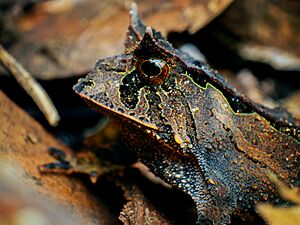Boie's frog facts for kids
Quick facts for kids Boie's frog |
|
|---|---|
 |
|
| Conservation status | |
| Scientific classification | |
| Synonyms | |
|
The Boie's frog (scientific name: Proceratophrys boiei) is a type of frog that belongs to the family Odontophrynidae. You can only find this frog in eastern and southeastern Brazil. It lives in different kinds of forests, like old-growth forests and newer ones. You can also find it at the edge of forests and in areas where the land has been changed by people.
Sadly, some Boie's frogs are illegally taken from their homes to be sold as pets. Their natural habitat is also shrinking. This happens because of farming, tree plantations, animal grazing, cutting down trees, building new towns, and tourism. The frog's scientific name, boiei, honors a German zoologist named Heinrich Boie or his brother Friedrich Boie.
What Does It Look Like?
The Boie's frog is a medium-sized, strong frog. It usually grows to be about 40 to 70 millimeters (1.6 to 2.8 inches) long. Male frogs are often a bit smaller than females.
This frog has a wide head and body. Its snout, which is its nose area, is rounded. Above its eyes, there are long, pointy bits of skin that look like small peaks. The skin on its back and sides is covered with bumps, called warts.
The frog's colors are a mix of brown, black, yellow, orange, and red. These colors form an uneven pattern that helps the frog blend in perfectly with dead leaves on the forest floor. This makes it very hard to see! It also has a wide brown or gray stripe down its back.
How It Lives and Eats
The Boie's frog mainly eats insects and their young, called larvae. Scientists have looked at what's inside their stomachs. They found that about 40% of their diet is beetles. Another 25% comes from orthopterans, which include grasshoppers and crickets.
When a Boie's frog feels scared or in danger, it jumps. Then, it flattens itself onto the fallen leaves. It makes its legs stiff and spreads them out. With its bumpy skin and amazing camouflage, it looks just like dead leaves. This trick helps it hide from animals that hunt by sight. This special defense pose has been seen in at least seven different frog species. One of these is Scythrophrys sawayae, another frog found in the forests of southeastern Brazil.
Conservation Status
The Boie's frog lives in many places and is thought to have a large total population. However, it faces some threats from human activities. These include clearing forests for farms, growing crops, and raising animals. Also, some frogs are caught and sold as pets, which is illegal.
The International Union for Conservation of Nature (IUCN) has looked at the Boie's frog. They have listed its conservation status as "least concern". This means they believe the frog's population is not decreasing fast enough to be considered more seriously threatened right now.
Images for kids




